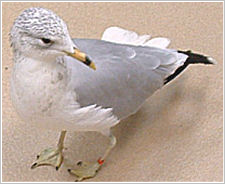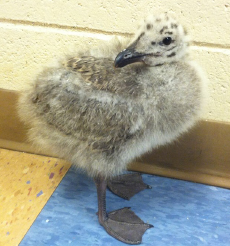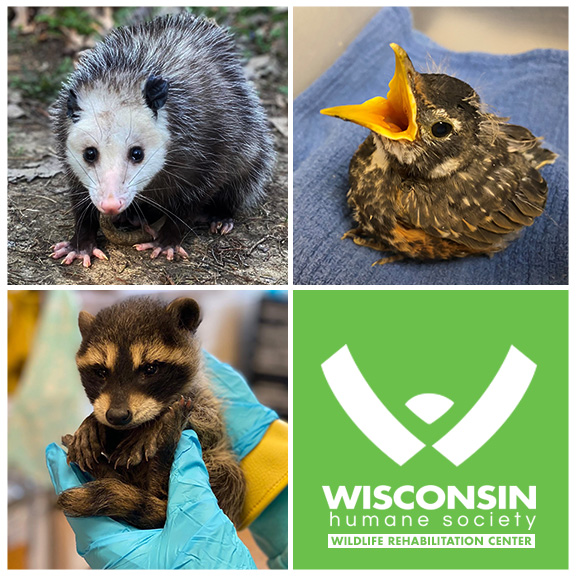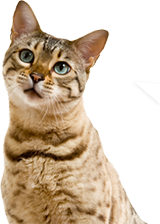Getting Along with Gulls
CLICK HERE for more information and a print-friendly PDF!
Situation:
You're having issues with gulls roosting or nesting on or around your building, boat, pier, or swimming area.
Why This Happens:
In recent years gulls have become increasingly common in urban environments. Some species of gulls are adapting to urban environments and are now nesting on gravel rooftops and in vacant lots, especially near water. Gulls have also learned to forage for discarded human food waste at landfills and wherever it can be found in urban areas.
Conflicts usually arise during nesting season when adult gulls may swoop down at people in an effort to protect their nests or chicks, and their nesting colonies can be very noisy and smelly. Other concerns include gull droppings on cars, boats, piers, and around businesses, and beach sanitation and water-quality issues at beaches.
FAQs & Humane Solutions:
“Gulls are eating food from in and around the dumpsters by my apartment building and defecating everywhere. How do I get them to stop?”
Encourage your tenants to keep the Dumpster lids closed at all times, and ask them to make sure that all garbage makes it into the Dumpster, not on the ground nearby. Any garbage on the ground or in an open receptacle will attract foraging gulls.
“I have workers on a roof downtown doing repairs on a cooling unit. My workers are being attacked by gulls. The gulls keep swooping down at them and I’m afraid someone is going to get hurt, what can we do?”
The gulls are swooping down because they believe your workers are a threat to their nests and young on that or a nearby roof. You may want to postpone doing the work if it is reasonable to do so. The gulls only defend their nesting area during the spring and early-to mid-summer nesting season. Once their young have fledged, they will disperse from the rooftop nesting area.
If the work can’t be postponed, using the following method usually works well to let your workers get a quick job done: One worker does the actual repair work while another serves as the “gull spotter.” The latter’s sole duty is to watch for approaching gulls and fend them away from the person doing the work. Both workers should wear hard hats and face or eye protection. The gulls seldom actually make contact with an “intruder,” but it’s better to be safe than sorry. A good tool for fending off gulls is a large, hand-held umbrella, especially a brightly colored or patterned one. The spotter holds the open umbrella over their head and waves and brandishes it to scare away any approaching gulls, while the other worker does the work. Even better than the “umbrella method”, erecting a popup canopy or suspending a tarp over the area being worked on helps deter the gulls and adds another layer of protection for the workers. The tarp or pop-up canopy is elevated a few feet off the ground, the lower the better; if reasonable to do so, the workers can kneel under the canopy situated just over their heads to do their repair work. For even more protection, covering one or more sides of the canopy should provide further concealment and protection for workers.
If you have questions, please contact our Wildlife Rehabilitation Center staff at 414-431-6204.
Gulls, like all migratory birds, are protected by state and federal laws and actions such as removing gull eggs or harassing the gulls to try to get them to leave during nesting season are illegal (without a special permit issued by the US Fish and Wildlife Service). If you believe the gull’s activity poses a real risk to human safety and you cannot postpone the work or use the techniques described above, or they have not worked to your satisfaction, you are welcome to call us at (414) 431-6204 for further advice. Or you may call the United States Department of Agriculture Wildlife Services office in your state for more information about how you might obtain a permit.
“There is a gray gull -- it looks like a young one -- walking around on a busy street downtown. Is there something I can do to help her?”
If it is summer, this is likely an infant or juvenile gull. Gulls often nest on rooftops and vacant lots in the city. These young birds are flightless for weeks after hatching and learn to fly from the ground up, so it is very common to see them walking in or around streets, sidewalks and parking lots when they wander away from their nest site.
Is it orphaned? If you see adult gulls coming down near the juvenile, it likely is being cared for and it doesn’t need human intervention for that reason. However, if the gull is in the street or otherwise in danger, or appears to be injured, you may choose to intervene. If you do choose to help, please be very careful and use your best judgment to protect your own safety and the safety of others. You may be able to hold a shirt or towel in front of you like a bull-fighter’s cape to herd the bird to safety. Please, if it is not safe for you to intervene, consider calling the police or a licensed wildlife rehabilitator for help. If you are uncertain about a situation, call a licensed wildlife rehabilitator in your area for advice. If you are in Milwaukee County, call us at (414) 431-6204. If you choose to capture the bird, you can refer to our Sick or Injured Birds page for tips.
“Our favorite beach is closed again because of water quality issues. Are the gulls on the beach to blame for this?”
In some cases, local bird droppings (gulls, geese, ducks, and pigeons) can be a significant contributor to elevated bacteria levels in beach water. Such is likely the case at Milwaukee’s South Shore Park beach where an expansive asphalt parking lot attracts these birds as a safe resting area. Rainwater then washes their waste into the adjacent sand and water. But “non-point source” pollution – pollution from diffuse sources such fertilizers, pesticides, and animal waste from agriculture and suburban and city lawns and streets, and human waste from sanitary sewer leaks and overflows upstream, washed into rivers and streams by rainwater and snow-melt – may also play a significant role.
Also, factors such as water circulation adjacent to beaches and the proximity of storm water run-off points to the beach can play a role. Using habitat modification -- changing some of the landscape features adjacent to and on the beach – can make the beach and adjacent areas less inviting to the birds. In the case of South Shore Park’s beach, officials will be modifying the expansive asphalt parking lot and adding dunes to the upper beach to make the area feel less “safe” for these birds to reduce their use of this area as a hang-out. They are also using a beach-grooming machine which turns over the beach sand, exposing lower layers to the pathogen-killing effects of sunlight.
“There are lots of gulls on the flat roof of our building. They nested up there last spring and summer and I don’t want them to nest up there again. What can we do to prevent that?”
In southern Wisconsin, you should begin watching for gulls congregating on the roof starting in late February, and into March and early April (in milder weather the gulls tend to show up earlier). These birds may be checking out the area for nesting weeks later. Before the birds actually lay eggs, it is legal and humane to take action to get the birds to leave and look elsewhere for a nesting spot. The options available to you fall under these three categories: Habitat Modification, Repellents, and Exclusion. Using a combination of techniques is often needed to obtain the desired results.
1. Habitat modification:
- Reduce or eliminate nearby food sources or the bird’s access to them. Sources of food for gulls include garbage at dumps or landfills, near restaurants, and at food processing plants.
- Manipulate the height of vegetation on a potential gull nest site by reducing or eliminating mowing (if allowed). Dense vegetation that is taller than the standing gulls may reduce their ability to see approaching predators. This can make them feel insecure and cause them to abandon the area.
- Drain or otherwise eliminate puddles and pools of standing water that attract gulls. (IMPORTANT: Don’t do this when there are baby gulls present. They are too young to fly and are dependent on water sources in or adjacent to their nesting colony to survive). Bird droppings are just one of several sources of contaminants that can negatively affect water quality at swimming beaches. Source: Pixabay Tall grasses or other plants limit gull’s ability to watch for potential predators so gulls usually avoid these areas.
2. Repellents/Scare Tactics:
These work best if started well before the gulls get attached to a potential nesting site. Habituation (getting so used to something it is no longer frightening) by the birds is common when using repellents or scare tactics, especially those that don’t move or change in some way, so it is best to use more than one of these methods, change the type or location of the scare tactic, and use them in combination with habitat modification and/or exclusion for best effect.
- Mylar tape - (Bird-X™ Irri-tape)
Hanging strips of Mylar tape that move and shimmer in the breeze can scare the birds away from some areas. One could also hang unwanted CDs (compact discs) to try for the same effect. Habituation can occur so make sure to change the objects and their location often. - Predator Kites
Flying kites or balloons resembling avian predators (e.g. hawks, falcons) can keep birds away from an area. But like all scare tactics, habituation to them can happen, sometimes in just days or even hours, so you’ll need to vary the location of the kites to maintain their effectiveness. - Noisemakers
Using loud sounds or other audible stimuli can effectively get birds to leave an area. However, their use is somewhat limited in urban areas due to the disturbance they can cause to people in nearby homes and businesses. Noisemakers can be as simple and inexpensive as banging pots and pans together in your hands, or as elaborate and expensive as automatic propane “exploders” and playing recorded bird distress calls on loudspeakers. The use of pyrotechnics such as “shell crackers” “screamers” and the like should be left to wildlife management professionals. - Methyl Anthranilate - (e.g. Fog Force® NIXALITE)
This is a non-toxic bird repellent (also used as an artificial grape flavoring in human foodstuffs) that tastes bad to most birds. For gulls, this product is usually applied as a fog that is created upwind from the gulls one wants to repel. The breeze carries the fog to the gulls. The gulls associate the bad taste of the fog with the location and often avoid it in the future. Various types of foggers are available for this purpose, including propane foggers, electric foggers, automatic foggers, and compression tank sprayers. Fogging needs to be repeated as needed to repel new or returning birds. - The Scarecrow® motion-activated sprayer
Hooks up to a garden hose and scares away birds entering its sensor area by blasting them with a harmless, though frightening, blast of water.
3. Exclusion
- Anti-gull colony String Grid
Is a grid of fishing line, or wires (usually stainless steel), mounted on poles so the string or wires are several feet above the ground over an area one wants to protect. For rooftops, the string or wire is usually attached to plastic or fiberglass poles and spaced 10 to 15 feet apart. The grid works because the gulls don’t like to fly through the network of lines or wires. IMPORTANT: A grid must be erected before the gulls begin nesting. Grids of wire or fishing line spaced as wide as 30 feet apart have been shown to keep gulls away from garbage dumps, if the food attraction is not too great. Wire spacing of 15 feet was successful in keeping most gulls away, even when the food attraction was great. Wire grids with spacing of 30 feet have successfully kept gulls away from fish-farming ponds. - Bird Spikes
Gulls can be dissuaded from perching on ledges and walls by using "bird spikes," sometimes called "porcupine wires." These are strips of bristling metal or plastic wires or spikes that make it very uncomfortable for gulls to land on surfaces to which they are properly applied. - The Bird Spider®
The Bird Spider does look somewhat like a wire spider with long, curved wire “legs” radiating from a central mounting point. This product can keep gulls from perching on poles, street lights, boat cabins and other areas up to several square feet in size. - Bird Netting
Weather-resistant netting with a mesh size small enough to keep a gull from passing through it is draped, or erected on a framework, over or around an area one wants to protect. Such netting and related supplies are available online, and some professional “nuisance wildlife control operators” are equipped to install bird netting. - Hire Help
If you are unwilling to tolerate or unable to haze the gulls yourself, there is the option to hire a humane animal removal company to do the work for you. For more information on choosing the right company for the job, click here.
“Gulls land on my sailboat and the dock where she’s tied up and their poop is everywhere. What can I do to keep them off my boat and the dock?"
See above for exclusion techniques and repellents/scare tactics that can help keep gulls off your boat and dock. Temporary mounts, including a handy sandbag-type base, are available for The Bird Spider® and similar devices for use on boats and other applications. Don’t waste your money on a plastic owl or an inflatable snake: the birds quickly learn that these static animal effigies are no threat and will ignore them. Fishing line or other string strung above likely gull landing areas is reportedly quite effective.
Restrict Gull Feeding: people feeding gulls intentionally or unintentionally (e.g. cleaning fish at dockside and tossing the entrails in the water) in the general area around your boat can attract gulls, which may hang around waiting for another hand-out.
“Gulls are nesting on a building near my workplace. Every day my car gets pooped on. Is there anything I can do to prevent this? What’s the best way to get the gull poop* off the car?”
You may have to walk a bit further from your car to work, or pay to park in a covered parking structure, but if you can reasonably find a parking place in a “safer-from-gull-poo” location, it might be worth the extra effort or cost - especially if you are particular about protecting your car’s like-new finish.
If parking elsewhere is out of the question, you instead might consider covering your car, or at least the areas most likely to be “hit,” such as the roof, hood and trunk lid. Commercial car covers are available at auto supply stores and online. Instead of buying an actual car cover you may want to first try covering vulnerable areas of your car with a blanket or other thick fabric while it is parked.
If your car is pooped on, it helps to wash it off quickly, before the hot sun bakes it on and the acidic poo possibly damages the car’s finish. There are a variety of methods offered online for the “best” way to wash bird droppings off of your car. Most involve soaking the poop with a water-soaked cloth or paper towel to soften it, and then “pinching” the poop with your fingers through the cloth or paper towel to lift it from the surface. Some suggest that wiping the mess off rather than lifting it off might scratch the finish due to a fine grittiness that may be present in the dropping.
There are also a variety of commercial bird-poop remover liquids, special protective car-finish waxes, sealants, glazes and films available. You may want to talk to your car’s detailer, dealer, or manufacturer for their recommendations for protecting your car’s finish and removing bird droppings.
*Birds don’t really produce urine like mammals do. Instead, they produce uric acid which collects in a chamber called the cloaca (they don’t have a bladder). In the cloaca, excess water is reabsorbed. The remaining pasty white stuff is expelled with their droppings. Thus, in bird “poo” the white stuff is uric acid and the brown/green/black stuff is the actual fecal matter.
CLICK HERE for more information and a print-friendly PDF!
For further advice about solving problems with gulls, you may contact us by phone at (414) 431-6204 or send us a message here.


.png)

